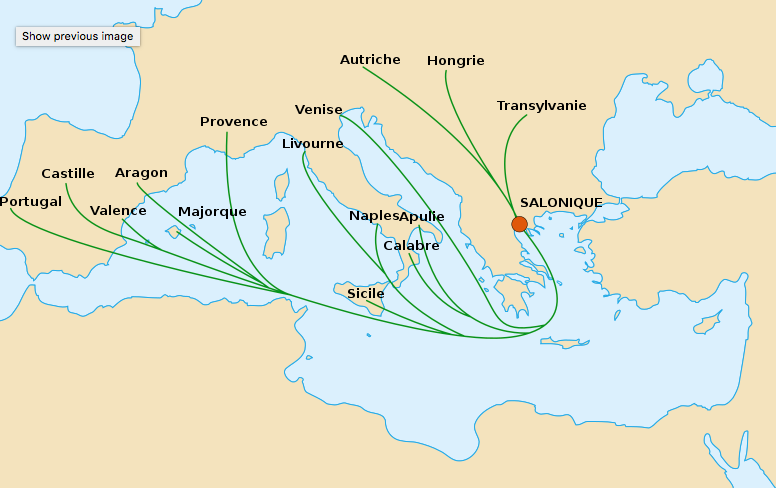*2nd Generation dance. A dance that developed and was disseminated in a non-traditional way. 2G dances are specific – have a fixed format designed to correspond with the arrangement of a particular recording., whereas 1G dances are generic – have a shorter sequence that works with live music – where many different songs are played and arrangements vary according to the tastes of musicians and dancers. For more on the differences between 1st & 2nd G dances click here.
Primavera en Salonico
[Spring in Salonica]
By 1492 Ferdinand and Isabella of Spain had finally driven the remaining Moors out of the country. Sephardic Jews (see https://folkdancefootnotes.org/culture/ethnicity-history-geography/jews-mizrahi-sephardim-ashkenazi/) were then given the choice of converting to Christianity, leaving the country, or death. Among the many places Sephardim chose for their exile, one was Salonica in the Ottoman Empire (now Thessaloniki, Greece).

According to Wikipedia:
The history of the Jews of Thessaloniki (Greece) reaches back two thousand years.
The city of Thessaloniki (also known as Salonika) housed a major Jewish community, mostly Eastern Sephardim, until the middle of the Second World War. It is the only known example of a city of this size in the Jewish diaspora that retained a Jewish majority for centuries.
Sephardic Jews immigrated to the city following their expulsion from Spain by Christian rulers under the Alhambra Decree in 1492. This community influenced the Sephardic world both culturally and economically, and the city was nicknamed la madre de Israel(mother of Israel). The community experienced a “golden age” in the 16th century, when they developed a strong culture in the city. Like other groups in the Ottoman Empire, they continued to practice traditional culture during the time when western Europe was undergoing industrialization. In the middle of the 19th century, Jewish educators and entrepreneurs came to Thessaloniki from Western Europe to develop schools and industries; they brought contemporary ideas from Europe that changed the culture of the city. With the development of industry, both Jewish and other ethnic populations became industrial workers and developed a large working class, with labor movements contributing to the intellectual mix of the city. After Greece achieved independence from the Ottoman Empire, it made Jews full citizens of the country in the 1920s.
During World War II, the Germans occupied Greece in 1941, and started to systematically persecute the Jews as they had in other parts of Europe. In 1943 they forced the Jews in Thessaloniki into a ghetto near the rail lines, and started deporting them to concentration camps and labor camps, where most of the 60,000 deported died. This resulted in the near-extermination of the community. Only 1200 Jews live in the city today.
For more detail on the Sephardim of Salonica, see https://en.wikipedia.org/wiki/History_of_the_Jews_in_Thessaloniki
In 1995 Greek musician Savina Yannatou (https://en.wikipedia.org/wiki/Savina_Yannatou) formed a jazz/traditional band called Primavera in Salonico and released a CD of traditional Sephardic Greek songs, one of which was called Primavera en Salonico.
That recording inspired Steve Kotansky to choreograph a dance he called Primavera en Salonico, based on Zeybekiko, which has a similar rhythm.
https://lyridsfolkdancefestival.org/wp-content/uploads/2016/04/PRIMAVERA-EN-SALONICO.pdf

The Lyrics:
| Primavera in salonico | Springtime in Salonica, |
| Halli al café Maslum | I found at Maslum’s cafe, |
| Una niña de ojos pretos | a girl with black eyes |
| Que canta y sona ud. | singing and playing the oud. |
| No me manques, tu Fortuna, | Oh, Fortuna, don’t be absent |
| del cafe de Avram Maslum. | from Avram Maslum’s cafe. |
| Tu quitas los muestros dertes, | You banish our sorrows |
| que cantas y sonas ud. | when you sing and play the oud. |
| El ud tomas en la mano | You take the oud in your hand |
| con gilves y con sacas. | with such airs and graces. |
| Los tus ojos relucientes | Your two shining eyes |
| a mi me hacen quemar. | have set me on fire. |
Source: CD by Savina Yannatou: “Primavera en Salonico”
